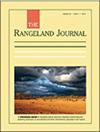气候变化的模拟、评估与政策响应——三江源地区草甸的分布与面积
IF 0.9
4区 环境科学与生态学
Q4 ECOLOGY
引用次数: 0
摘要
特定草地类型的合理分布如何响应政策实施和气候变化,是草地有效管理和可持续发展的前提和基础。利用MaxEnt模型作为物种水平上的综合评价方法,成功地模拟了政策实施和气候变化背景下三江源地区草甸地理分布的时空变化。主要有三个发现。首先,有影响草甸分布的6个优势环境变量(高程、降水变异系数、3月降水、4月降水、4月最低气温和5月最低气温),它们的阈值分别为3500 ~ 4000 m、86 ~ 100 m、8.5 mm、12 mm、-3.5°C和1.5°C,表明草甸分布的最适宜条件。②在当前(2005-2014)气候条件下,草甸适宜分布自东向西逐渐减少,东部面积最大;三峡库区生态保护政策的实施,极大地改善了低海拔高人口地区的生态环境。这有利于草甸的生长,扩大了草甸的适宜面积。(3) 4种代表性浓度路径情景下,2050年代(2041 ~ 2060年)和2070年代(2061 ~ 2080年),草甸适宜生长面积分别比当前增加25.4 ~ 33.0%和17.4 ~ 33.0%。更重要的是,从本世纪50年代到70年代,适合Kobresia草甸的面积将减少或稳定,为保护和利用带来新的挑战。本文章由计算机程序翻译,如有差异,请以英文原文为准。
Modelling and assessment of climate change and policy response – the distribu tion and area of Kobresia meadow in the Three-River Headwaters Region, China
How the suitable distribution of a given grassland type will respond to policy implementation and climate change is a prerequisite and the basis for effective grassland management and sustainable development. The maximum entropy (MaxEnt) model as a comprehensive evaluation method at species level was successfully used to simulate the temporal and spatial changes in the geographical distribution of Kobresia meadow in China’s Three-River Headwaters (TRH) region under the context of policy implementation and climate change. There were three main findings. First, there are the six dominant environmental variables affecting the distribution of Kobresia meadow (these being elevation, precipitation variation coefficient, March precipitation, April precipitation, April minimum temperatures, and May minimum temperatures: their threshold values are 3500–4000 m, 86–100, 8.5 mm, 12 mm, –3.5°C and 1.5°C, respectively, which indicate the most suitable conditions for Kobresia meadow distribution). Second, under current (2005–2014) climate conditions, the suitable distribution of Kobresia meadow gradually decreases from east to west, with the largest area in the east. Implementation of the ecological conservation policy in the TRH has greatly improved the ecological environment in lower elevation and high population areas. This has benefited the growth of Kobresia meadow and enlarged its suitable areas. Third, compared with the current distribution, areas suitable for Kobresia meadow will increase by 25.4–33.0% in the 2050s (2041–2060) and 17.4–33.0% in the 2070s (2061–2080) under four Representative Concentration Pathway (RCP) scenarios. More importantly, from the 2050s to the 2070s, areas suitable for Kobresia meadow will decrease or stabilise, bringing new challenges for protection and utilisation.
求助全文
通过发布文献求助,成功后即可免费获取论文全文。
去求助
来源期刊

Rangeland Journal
环境科学-生态学
CiteScore
2.90
自引率
8.30%
发文量
14
审稿时长
>36 weeks
期刊介绍:
The Rangeland Journal publishes original work that makes a significant contribution to understanding the biophysical, social, cultural, economic, and policy influences affecting rangeland use and management throughout the world. Rangelands are defined broadly and include all those environments where natural ecological processes predominate, and where values and benefits are based primarily on natural resources.
Articles may present the results of original research, contributions to theory or new conclusions reached from the review of a topic. Their structure need not conform to that of standard scientific articles but writing style must be clear and concise. All material presented must be well documented, critically analysed and objectively presented. All papers are peer-reviewed.
The Rangeland Journal is published on behalf of the Australian Rangeland Society.
 求助内容:
求助内容: 应助结果提醒方式:
应助结果提醒方式:


